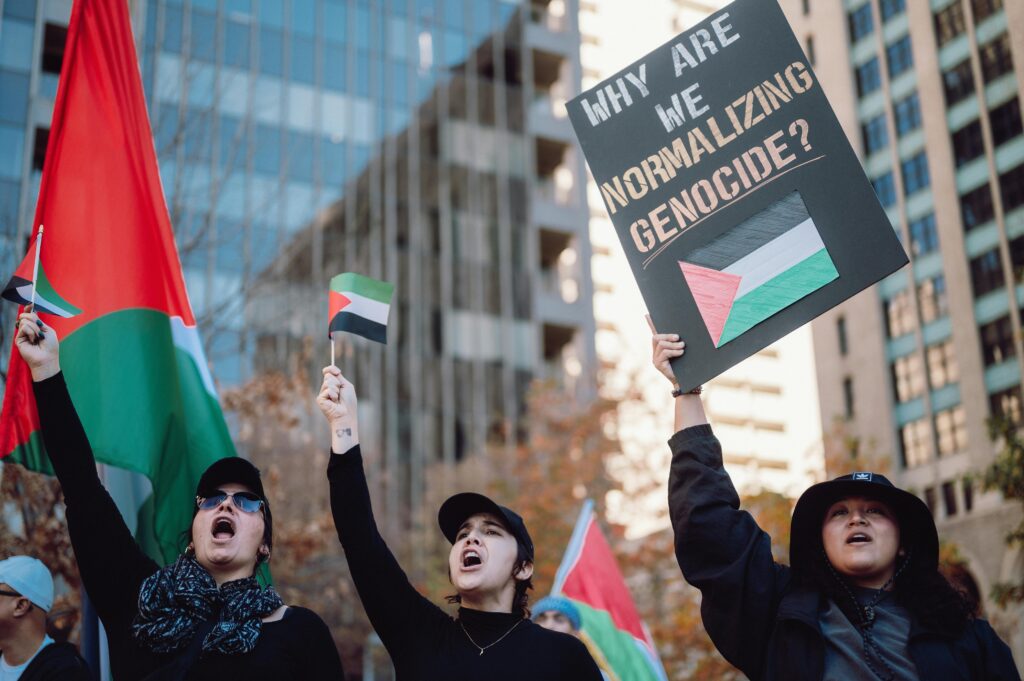Published on 20th April 2025
Authored By: Mannat
Rajiv Gandhi National University of Law
Abstract
Human trafficking is a prevalent type of transnational organized crime that involves the exploitation of persons for profit, often in the form of forced labor or commercial sexual exploitation. It affects millions of people around the world and earns criminal organizations huge amounts of money, which is in billions of dollars annually. The United Nations Convention against Transnational Organized Crime (UNTOC) and its related protocols have been instrumental in establishing human trafficking as a major global issue, thus highlighting the need for international cooperation to combat it. While progress has been made, there are still many challenges, especially in improving the enforcement of legal mechanisms and addressing the root causes of trafficking, including poverty and social inequality. Moreover, the role of technology in facilitating and fighting trafficking is a critical consideration. This paper explores the complexities of human trafficking in the broader context of transnational crime, highlighting the necessity of continued international cooperation and creative strategies to dismantle financial networks and successfully protect victims.
Introduction to Human Trafficking and Transnational Crime
Human trafficking is a form of modern-day slavery that involves the illegal transport of individuals by force or deception for the purpose of exploitation, often for sex or labor[1]. Transnational organized crime is a significant issue that encompasses a range of illegal activities crossing national borders, including drug trafficking, arms trafficking, and money laundering.[2]
Definition and Types
Human trafficking is the recruitment, transportation, transfer, harboring, or receipt of individuals by means of threats, force, coercion, abduction, fraud, deception, the abuse of power, or exploiting a vulnerability for the purpose of exploitation[3]. The exploitation can take many forms, including forced labor, sexual exploitation, slavery, or practices similar to slavery.
Causes and Factors
Poverty and Economic Inequality: Traffickers often target people from economically poor backgrounds by promising them better economic opportunities.[4]
Globalization: While globalization has opened up more economic opportunities, it has also facilitated the expansion of transnational criminal networks.[5]
Conflict and Displacement: Areas affected by conflict or natural disasters are particularly vulnerable to trafficking, as these conditions tend to displace populations.[6]
Tactics and Routes
The traffickers have various strategies in use, for example, fraudulent job postings, false documents, and force. They operate under complex networks spread across many different countries, and they often share the same routes as other illegal goods.[7]
The Role of International Cooperation
International cooperation is important in the combating of human trafficking:
Legislative Frameworks: Countries need to establish robust legal frameworks to prosecute traffickers and protect victims.
Extradition and Mutual Assistance: International agreements facilitate the extradition of traffickers and offer mutual legal assistance in investigations.[8]
Victim Support: Providing support and protection to victims is important, as this is vital for their recovery and for encouraging them to cooperate with law enforcement.[9]
Future Strategies
In order to efficiently combat human trafficking, forthcoming efforts should focus on:
Disrupting Financial Networks: Plans must be to attack the economic means that sustain traffic operations.[10]
Increasing International Cooperation: More robust collaboration between nations can make anti-trafficking efforts more effective.[11]
Addressing Root Causes: Dealing with poverty, inequality, and conflict can reduce the vulnerability of communities to traffic.[12]
Transnational Crime: An Expanded Overview
Transnational crime encompasses a broad range of criminal activities, beyond human trafficking, to cover drug trafficking, arms trafficking, and cybercrime. These crimes tend to overlap and support each other, hence making it more challenging to tackle them effectively.
Drug Trafficking
Among transnational crimes, drug trafficking is one of the most lucrative, having significant impacts on public health and security. Disrupting drug trafficking networks requires cooperation from several countries, since these networks rely on complex financial and logistical systems.
Arms Trafficking
The illicit trafficking of firearms has a key function to play in enabling other forms of transnational crime by providing weapons that may be used in acts of violence or to intimidate victims. Combating arms trafficking requires cooperative action to monitor and control the cross-border flow of weapons.
Cybercrime
As a result of digital technologies, cybercrime encompassing online identity theft and online fraud has mushroomed in occurrences. The crime frequently supports other cross-border crime through provision of platforms for money fraud and impersonation.
The Importance of Global Conventions
In 2000, the United Nations General Assembly ratified the United Nations Convention against Transnational Organized Crime (UNTOC), a milestone step in the worldwide effort to counter transnational crime.[13] The convention is joined by three separate protocols:
- Protocol to Prevent, Suppress and Punish Trafficking in Persons, Especially Women and Children: This protocol provides the world’s first generally accepted definition of human trafficking with the goal of protecting victims as well as stimulating international cooperation to combat trafficking.
- Protocol against the Smuggling of Migrants by Land, Sea and Air: It targets the topic of migrant smuggling as distinct from trafficking by focusing on the illicit transport of individuals more than the exploitation of these persons.[14]
- Protocol against the Illicit Manufacturing of and Trafficking in Firearms, their Parts and Components and Ammunition: It aims to address illegal trade in arms, which commonly fuels other categories of transnational crimes.
Influence of the Convention
The United Nations Convention against Transnational Organized Crime (UNTOC) and the related protocols have had an impact in a number of areas:
Global Cooperation: These instruments have encouraged global cooperation by providing platforms for extradition, mutual legal aid, and police cooperation.
Juridical Frameworks: The protocols have inspired countries to put in place local legislation for addressing organized crime, such as crimes involving money laundering and corruption.
Protection of Victims: The trafficking protocol gives a high priority to the protection of the human rights of victims and sets forth procedures for their assistance.[15]
Challenges and Future Directions
Despite these advances, there are some challenges that remain:
Implementation and Enforcement: Increased implementation and enforcement of the Convention and its protocols in each country is urgently needed.[16]
Financial Concerns: Transnational crime, most notably human trafficking, is incredibly lucrative with projections that show that it creates roughly $150.2 billion yearly. Campaigns against the same need to address the disrupting of financial cycles and networks which specialize in money laundering.
Internationalization and Technological Advancement: Increased connectivity within the world as well as developments in technology have led to increased networks for transnational crimes.[17]
Recommendations for Future Action
Strengthen Legal Frameworks: States should continue to strengthen their legal frameworks to facilitate proper prosecution of traffickers and protection of victims.
Enhance International Cooperation: There needs to be enhanced cooperation among countries through regular meetings, intelligence sharing, and joint operations.
Deal with Financial Networks: Initiatives ought to focus on the disruption of financial networks which support trafficking practices, such as putting in place anti-money laundering measures.
Support Victims: The provision of complete support to the victims is very crucial since this plays a very significant role towards their recovery, as well as for encouraging them to cooperate with law enforcement agencies.
Role of Technology
Technology has a two-pronged role to play in the scenario of human trafficking; it can be used against victims by traffickers and, at the same time, provide means to prevent such crimes. Improvements in data analysis and digital forensics play a crucial role in locating traffickers and shutting down their networks. In addition, online platforms are capable of efficiently raising awareness and delivering vital information to vulnerable persons.
Civil Society and NGOs
Organizations in civil society and non-governmental organizations (NGOs) play a key role in the struggle against human trafficking. They provide essential support services to victims, raise awareness, and push for policy changes required. Their activities complement those of the government to ensure victims’ needs are met.
Economic Development
Combating the economic imperatives driving trafficking is of overarching concern. Projects focusing on economic growth that are built on enhancing education and jobs have the power to drastically lower the vulnerability of potential populations to trafficking. These include investments in schooling, technical education schemes, and social schemes benefitting outcasts.
Conclusion
Human trafficking is an important element of transnational organized crime, for which the UN Convention against Transnational Organized Crime has acted as a bulwark for international action. Despite progress having been made, many challenges still remain. Enduring international cooperation, together with new ways to break up economic networks and address root causes, is essential if these crimes are to be adequately eliminated.
Final Thoughts
Combating human trafficking requires a holistic approach that addresses underlying causes, dismantles economic networks, and protects victims. Through concerted efforts and the leveraging of technology, civil society, and economic efforts, the global community can make significant progress against human trafficking and transnational crime. It is important to continue efforts in raising awareness, assisting victims, and strengthening international cooperation to create a safer and more just world for all.
References
[1] ‘Human Trafficking’ (Encyclopædia Britannica, 3 March 2025) <https://www.britannica.com/topic/human-trafficking> accessed 13 March 2025
[2] (Transnational organized crime) <https://chss.rowan.edu/centers/inter_majors/interdisciplinary_programs/internationalstudies/global_security_resource/global-security-problems-folder/transnational-organized-crime.html> accessed 13 March 2025
[3] United Nations, Human Rights and Human Trafficking: Fact Sheet No. 36 (New York and Geneva, 2014).
[4] ‘Human Trafficking’ (Encyclopædia Britannica, 3 March 2025) <https://www.britannica.com/topic/human-trafficking> accessed 13 March 2025
[5]https://chss.rowan.edu/centers/inter_majors/interdisciplinary_programs/internationalstudies/global_security_resource/global-security-problems-folder/transnational-organized-crime.html
[6] ‘Human Trafficking’ (Encyclopædia Britannica, 3 March 2025) <https://www.britannica.com/topic/human-trafficking> accessed 13 March 2025
[7] ‘Human Trafficking’ (Encyclopædia Britannica, 3 March 2025) <https://www.britannica.com/topic/human-trafficking> accessed 13 March 2025
[8] ‘United Nations Convention against Transnational Organized Crime’ (United Nations : Office on Drugs and Crime) <https://www.unodc.org/unodc/en/organized-crime/intro/UNTOC.html> accessed 13 March 2025
[9] United Nations, Human Rights and Human Trafficking: Fact Sheet No. 36 (New York and Geneva, 2014).
[10] ‘Transnational Crime’ (Global Financial Integrity, 31 October 2022) <https://gfintegrity.org/issue/transnational-crime/> accessed 13 March 2025
[11] ‘United Nations Convention against Transnational Organized Crime’ (United Nations : Office on Drugs and Crime) <https://www.unodc.org/unodc/en/organized-crime/intro/UNTOC.html> accessed 13 March 2025
[12] Human Trafficking’ (Encyclopædia Britannica, 3 March 2025) <https://www.britannica.com/topic/human-trafficking> accessed 13 March 2025
[13] United Nations Convention against Transnational Organized Crime’ (United Nations : Office on Drugs and Crime) <https://www.unodc.org/unodc/en/organized-crime/intro/UNTOC.html> accessed 13 March 2025
[14] United Nations Convention against Transnational Organized Crime’ (United Nations : Office on Drugs and Crime) <https://www.unodc.org/unodc/en/organized-crime/intro/UNTOC.html> accessed 13 March 2025
[15] United Nations, Human Rights and Human Trafficking: Fact Sheet No. 36 (New York and Geneva, 2014).
[16] Rose C, ‘The Creation of a Review Mechanism for the UN Convention against Transnational Organized Crime and Its Protocols: American Journal of International Law’ (Cambridge Core, 17 January 2020) <https://www.cambridge.org/core/journals/american-journal-of-international-law/article/creation-of-a-review-mechanism-for-the-un-convention-against-transnational-organized-crime-and-its-protocols/B82CB7D6B9A92F5D7839764ADD26C418> accessed 13 March 2025
[17] Human Trafficking’ (Encyclopædia Britannica, 3 March 2025) <https://www.britannica.com/topic/human-trafficking> accessed 13 March 2025




